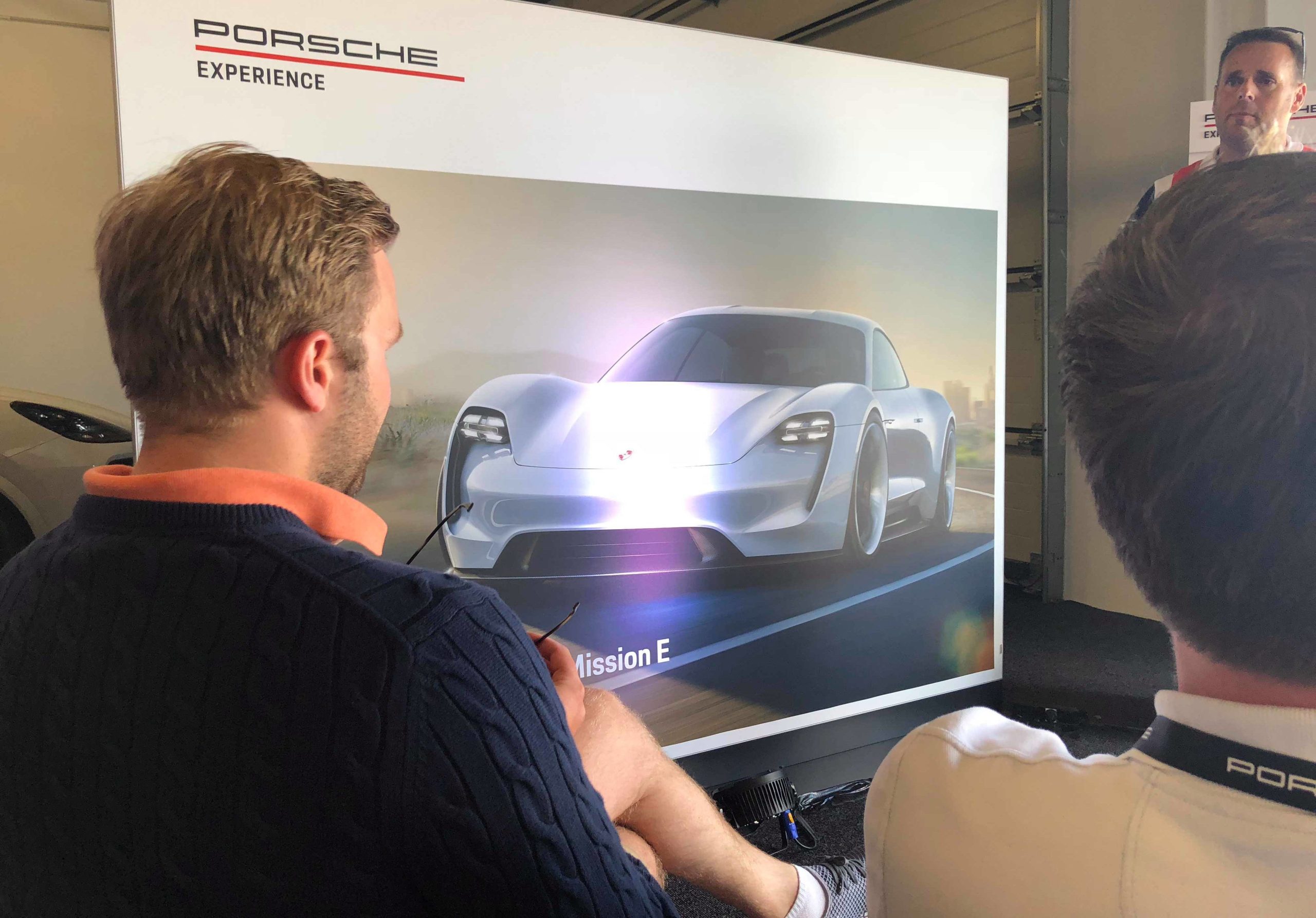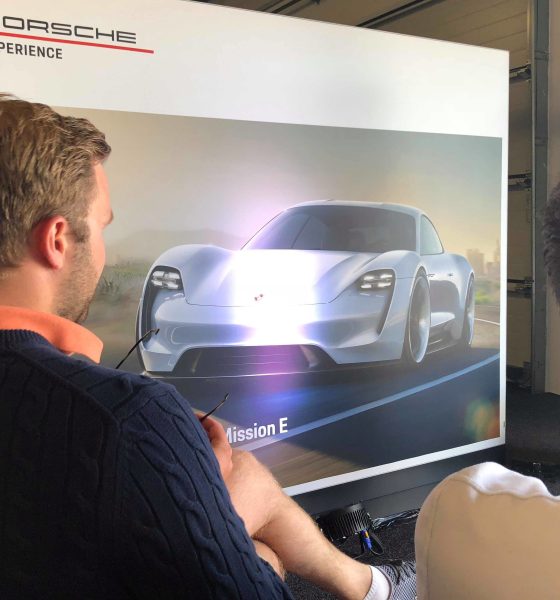

News
A Tesla Model S owner’s tale of how he pre-ordered the Porsche Taycan (Mission E) in Norway
Car enthusiast and Norway-based Model S owner Jim Roger Johansen admits that while his heart is with Tesla, the Porsche Taycan (formerly referred to as the Mission E sedan), “is something else.” Having a fondness for high-performance vehicles, Johansen states that he wants a high-performance electric car, but the next-generation Tesla Roadster, which starts at $200,000, is out of his price range. He is hoping that the Porsche Taycan would be the ideal vehicle to fill the gap between his Model S family car and the hypercar-beating next-generation Roadster.
Earlier this year, Johansen visited a Porsche dealer, expressing his interest in the vehicle then known as the Mission E sedan. During his visit, Porsche kept his email address and advised him that he would be receiving updates about the car. This April, he received a message from the German legacy automaker stating that the pre-orders for the Taycan are being opened for Norway. In order to keep his place in the priority queue for the vehicle, he was asked to pay Kr20,000 (about $2,250) on or before April 25.
In a statement to Teslarati, Johansen, who runs the Porsche Taycan Norway Facebook group, stated that Porsche’s reservation process for the Taycan was quick and straightforward. He was directed to a payment page for Norway-based customers, and after a quick credit card transaction, he found himself as one of Norway’s Porsche Taycan reservation holders. A confirmation email later sent to Johansen advised him to wait for a call from his favored Porsche dealer, where he would configure his Taycan according to his preferences.
- A screenshot of Porsche’s confirmation email after paying the reservation fee for the Taycan. [Credit: Jim Roger Johansen]
- The homepage of the 2018 Porsche Festival in Norway.
In a follow-up email after his payment, Porsche stated that the reservations for the vehicle were only opened for Norway then, considering that the country is an “extraordinary market” for electric cars.
“In Norway, we have an extraordinary market for electric cars, and we are currently the only country in the world to offer Porsche Taycan pre-booking. In other words, we are out early, asking for understanding that a lot of information about the car is not yet available.”
Earlier this month, Johansen received an update from the legacy carmaker, giving him free tickets to the upcoming 2018 Porsche Festival in Norway, which would be held on September 8-9. In an email about the event, Porsche stated that the complimentary tickets are a small way for the company to give back to early reservation holders for the all-electric vehicle. The final production version of the Taycan, after all, has not been unveiled to the public yet. Thus, reservation holders such as Johansen are counting on Porsche’s word that the final design of the vehicle would be akin to the stunning Mission E concept that still dominates the Taycan’s promotional materials today.
The 2018 Porsche Festival will feature a number of family-oriented events, such as LEGO motorsport-inspired activities, car shows, and go-carts. Mark Webber, a professional racing driver who was featured in a Mission E test drive video earlier this year, is also expected to be in attendance on the festival. With roughly more than 2,300 reservation holders for the Porsche Taycan in Norway as of date, Johansen is hoping that a teaser for the vehicle’s final production version would be unveiled sometime during the Porsche Festival.
Expectations are high that the Taycan would be released sometime in 2019. Johansen, however, believes that he would likely get his car around 2020. By that time, he is hoping to have the Porsche Taycan parked beside his family car, a Tesla Model S sedan with a (hopefully) refreshed interior, a slightly updated design, and 2170 batteries for even longer range.

Elon Musk
Tesla’s Elon Musk: 10 billion miles needed for safe Unsupervised FSD
As per the CEO, roughly 10 billion miles of training data are required due to reality’s “super long tail of complexity.”

Tesla CEO Elon Musk has provided an updated estimate for the training data needed to achieve truly safe unsupervised Full Self-Driving (FSD).
As per the CEO, roughly 10 billion miles of training data are required due to reality’s “super long tail of complexity.”
10 billion miles of training data
Musk comment came as a reply to Apple and Rivian alum Paul Beisel, who posted an analysis on X about the gap between tech demonstrations and real-world products. In his post, Beisel highlighted Tesla’s data-driven lead in autonomy, and he also argued that it would not be easy for rivals to become a legitimate competitor to FSD quickly.
“The notion that someone can ‘catch up’ to this problem primarily through simulation and limited on-road exposure strikes me as deeply naive. This is not a demo problem. It is a scale, data, and iteration problem— and Tesla is already far, far down that road while others are just getting started,” Beisel wrote.
Musk responded to Beisel’s post, stating that “Roughly 10 billion miles of training data is needed to achieve safe unsupervised self-driving. Reality has a super long tail of complexity.” This is quite interesting considering that in his Master Plan Part Deux, Elon Musk estimated that worldwide regulatory approval for autonomous driving would require around 6 billion miles.
FSD’s total training miles
As 2025 came to a close, Tesla community members observed that FSD was already nearing 7 billion miles driven, with over 2.5 billion miles being from inner city roads. The 7-billion-mile mark was passed just a few days later. This suggests that Tesla is likely the company today with the most training data for its autonomous driving program.
The difficulties of achieving autonomy were referenced by Elon Musk recently, when he commented on Nvidia’s Alpamayo program. As per Musk, “they will find that it’s easy to get to 99% and then super hard to solve the long tail of the distribution.” These sentiments were echoed by Tesla VP for AI software Ashok Elluswamy, who also noted on X that “the long tail is sooo long, that most people can’t grasp it.”
News
Tesla earns top honors at MotorTrend’s SDV Innovator Awards
MotorTrend’s SDV Awards were presented during CES 2026 in Las Vegas.

Tesla emerged as one of the most recognized automakers at MotorTrend’s 2026 Software-Defined Vehicle (SDV) Innovator Awards.
As could be seen in a press release from the publication, two key Tesla employees were honored for their work on AI, autonomy, and vehicle software. MotorTrend’s SDV Awards were presented during CES 2026 in Las Vegas.
Tesla leaders and engineers recognized
The fourth annual SDV Innovator Awards celebrate pioneers and experts who are pushing the automotive industry deeper into software-driven development. Among the most notable honorees for this year was Ashok Elluswamy, Tesla’s Vice President of AI Software, who received a Pioneer Award for his role in advancing artificial intelligence and autonomy across the company’s vehicle lineup.
Tesla also secured recognition in the Expert category, with Lawson Fulton, a staff Autopilot machine learning engineer, honored for his contributions to Tesla’s driver-assistance and autonomous systems.
Tesla’s software-first strategy
While automakers like General Motors, Ford, and Rivian also received recognition, Tesla’s multiple awards stood out given the company’s outsized role in popularizing software-defined vehicles over the past decade. From frequent OTA updates to its data-driven approach to autonomy, Tesla has consistently treated vehicles as evolving software platforms rather than static products.
This has made Tesla’s vehicles very unique in their respective sectors, as they are arguably the only cars that objectively get better over time. This is especially true for vehicles that are loaded with the company’s Full Self-Driving system, which are getting progressively more intelligent and autonomous over time. The majority of Tesla’s updates to its vehicles are free as well, which is very much appreciated by customers worldwide.
Elon Musk
Judge clears path for Elon Musk’s OpenAI lawsuit to go before a jury
The decision maintains Musk’s claims that OpenAI’s shift toward a for-profit structure violated early assurances made to him as a co-founder.

A U.S. judge has ruled that Elon Musk’s lawsuit accusing OpenAI of abandoning its founding nonprofit mission can proceed to a jury trial.
The decision maintains Musk’s claims that OpenAI’s shift toward a for-profit structure violated early assurances made to him as a co-founder. These claims are directly opposed by OpenAI.
Judge says disputed facts warrant a trial
At a hearing in Oakland, U.S. District Judge Yvonne Gonzalez Rogers stated that there was “plenty of evidence” suggesting that OpenAI leaders had promised that the organization’s original nonprofit structure would be maintained. She ruled that those disputed facts should be evaluated by a jury at a trial in March rather than decided by the court at this stage, as noted in a Reuters report.
Musk helped co-found OpenAI in 2015 but left the organization in 2018. In his lawsuit, he argued that he contributed roughly $38 million, or about 60% of OpenAI’s early funding, based on assurances that the company would remain a nonprofit dedicated to the public benefit. He is seeking unspecified monetary damages tied to what he describes as “ill-gotten gains.”
OpenAI, however, has repeatedly rejected Musk’s allegations. The company has stated that Musk’s claims were baseless and part of a pattern of harassment.
Rivalries and Microsoft ties
The case unfolds against the backdrop of intensifying competition in generative artificial intelligence. Musk now runs xAI, whose Grok chatbot competes directly with OpenAI’s flagship ChatGPT. OpenAI has argued that Musk is a frustrated commercial rival who is simply attempting to slow down a market leader.
The lawsuit also names Microsoft as a defendant, citing its multibillion-dollar partnerships with OpenAI. Microsoft has urged the court to dismiss the claims against it, arguing there is no evidence it aided or abetted any alleged misconduct. Lawyers for OpenAI have also pushed for the case to be thrown out, claiming that Musk failed to show sufficient factual basis for claims such as fraud and breach of contract.
Judge Gonzalez Rogers, however, declined to end the case at this stage, noting that a jury would also need to consider whether Musk filed the lawsuit within the applicable statute of limitations. Still, the dispute between Elon Musk and OpenAI is now headed for a high-profile jury trial in the coming months.










